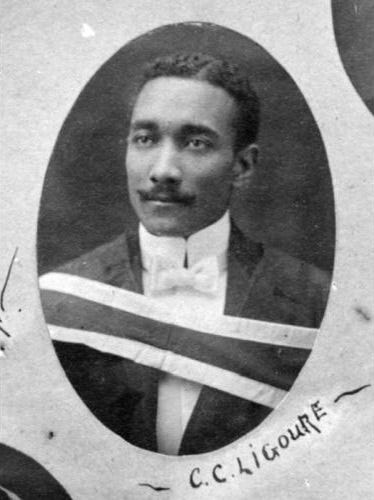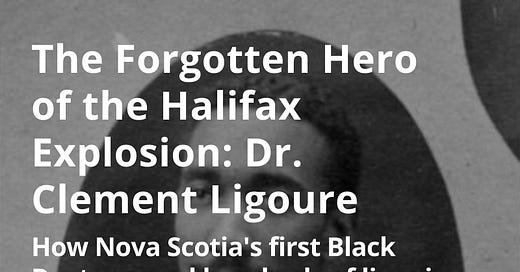The Forgotten Hero of the Halifax Explosion: Dr. Clement Ligoure
How Nova Scotia's first Black Doctor saved hundreds of lives in Canada's worst disaster—and why history almost forgot him

Imagine you’re standing on a street in Halifax in December 1917. The air is cold, and the harbour is alive with ships moving goods for the war effort. You might be a dockworker, or maybe you’ve just stepped off the ferry. Suddenly two vessels collide in the harbour and the streets erupt into chaos.
The largest man-made explosion before the atomic bomb transforms the city into a scene of shattered windows, collapsed buildings, and thousands of wounded people crying for help. Most of Halifax’s medical facilities are overwhelmed—some are destroyed outright.
But there’s one small hospital on North Street, run by a Trinidadian-born doctor named Clement Ligoure. Nobody assigned him to be the area’s first responder, and no one gave him extra resources. Yet he hurriedly throws open his doors and provides free compassionate treatment to everyone who staggers in or gets carried in on makeshift stretchers.
Dr. Clement Courtenay Ligoure was Nova Scotia’s first Black physician.
He was born on October 13, 1887, in San Fernando, Trinidad, to a family that valued education and community. His father was a deputy marshal and accountant in Trinidad’s court system, and his mother, Amanda, passed on a sense of caring that would shape Clement’s entire life. By the early 1900s, he left the Caribbean, looking for better opportunities in North America. He spent some time in New York, then found his way to Queen’s University in Kingston, Ontario.
Back then, Queen’s was still admitting Black medical students, though it would soon shut its doors to them. In 1916, Ligoure graduated with his Doctor of Medicine degree—two years before Queen’s started banning Black applicants. A ban that remained in effect for the next 47 years until 1965.
You might think that with a fresh medical degree back in the day, the sky would be the limit.
But when he arrived in Halifax in 1916, Dr. Ligoure was turned away by hospital after hospital. Prejudice was thick, and he was blocked from practicing in mainstream facilities purely because he was Black. Instead of giving up, he rented a house on North Street, naming it the “Amanda Private Hospital” after his mother. It had 15 beds—his entire operation—and he funded it himself.
At that time in Canada, there was no universal healthcare.
Doctors usually charged patients directly, on a fee-for-service basis, or sometimes used sliding scales to help poorer patients. But Dr. Ligoure took it to another level: he refused to turn anyone away. If someone couldn’t pay, he still treated them. That kindness put him under crushing financial pressure, but he felt he had no choice. After all, he’d come to Canada to heal people, not to watch them suffer just because they lacked money.
So, in December 1917, when the Halifax Explosion tore the city apart, Dr. Ligoure’s small hospital became a lifeline.
People with broken bones, deep cuts, and even missing limbs found their way to North Street. Some crawled on their own, some were carried in by relatives or neighbours. The city was in shock. Word spread quickly that there was a doctor here who didn’t care who you were or how badly you were hurt. He would treat you, and he wouldn’t charge a dime.
Dr. Ligoure worked around the clock after the explosion—almost 20 hours a day, by many accounts.
He had only two helpers at first: his housekeeper, who was actually his aunt, and a Pullman porter who happened to be staying at his house. Even with their help, he was swamped. Patients lay on floors, on makeshift cots, and on any spare bedding they could find. They had severe burns, open wounds, missing fingers and toes. Yet he kept going, shifting from bedside to bedside, even driving out in his own car—through snowstorms—to visit people who were too injured to travel.
He then reached out to the authorities to get some formal support.
After three days of nonstop work, the city finally recognized his operation as the No. 4 Dressing Station. Military nurses and supplies arrived, offering a bit of relief, but it was still an enormous job. First-hand accounts show that at one point, Dr. Ligoure was seeing upwards of 180 patients a day. And because most of them couldn’t pay, he didn’t charge anything. The Halifax Relief Commission eventually reimbursed him for some gasoline, but that was about it.
When Dr. Ligoure later testified before the Halifax Relief Commission, he described horrendous injuries—jaws split open, limbs nearly torn off, pieces of glass embedded in people’s faces.
He never stopped, even when rumours spread that another explosion might happen. He simply kept going, believing that every second counted for those in pain. By January 1918, he was still treating dozens of survivors, some dealing with infections or complications from earlier wounds.
His life was already dedicated to serving the Black community in Halifax, which had few medical options.
Before the explosion, he had co-founded the No. 2 Construction Battalion—Canada’s only all-Black battalion in World War I—alongside other community leaders. He recruited Black men from across the country, raised funds for them, and tried to become the battalion’s official physician. But once again, racism stood in the way, and officials claimed he failed his medical exam by a single point.
On top of this, he ran a newspaper called The Atlantic Advocate, where he wrote about civil rights and social justice issues.
He also served as a doctor for Black railway porters who weren’t welcome in many mainstream clinics. In the Halifax of that era, there was no shortage of barriers. But every time he hit a roadblock, Dr. Ligoure found a way to keep serving.
But after the initial wave of disaster relief, Dr. Ligoure’s life got even harder.
Because he never turned anyone away and covered so many of their medical costs out of his own pocket, his private hospital ran into deep financial trouble. By the early 1920s, he couldn’t keep up with the liens against his property. The very house that had saved so many lives ended up returning to its previous owners.
Even before losing his hospital, Dr. Ligoure faced constant reminders that the wider community didn’t fully accept him.
He had proven his skill and compassion in a crisis that shook an entire city, yet he couldn’t gain hospital privileges or secure a stable income. Though some local newspapers praised his work right after the Explosion, that recognition didn’t translate into long-term support or funding.
Eventually, Dr. Ligoure’s health gave out.
Some historians believe he caught tuberculosis around 1919, forcing him to scale back his medical practice. In 1921, he returned to Trinidad, possibly to be near family or to recover in a more familiar environment. Sadly, by May 1922, he had died there at just 34 years old—officially from malaria, but details are sparse. To make matters worse, Halifax never gave him a proper obituary. His burial site remains unknown, and for many decades, his name slipped into obscurity.
Only recently has his story been reclaimed. Researchers, playwrights, and local advocates like Peggy Cameron and William Breckenridge began unearthing his records and pushing for recognition.
And, as is often the case, it was children who showed us adults the right thing to do. A grade one class at École St. Catherine’s Elementary School in Halifax spearheaded efforts to honour Dr. Ligoure’s legacy. Students in Natasha Camacho’s class wrote letters to Halifax’s city council to request a plaque at his former clinic. Then they also wrote letters endorsing the formal application to grant heritage status to the clinic.
In 2023, Dr. Ligoure’s North Street Hospital won heritage designation, ensuring that this piece of Canadian history isn’t forgotten.
Dr. Ligoure has become a symbol of what one person can accomplish, even under the heaviest weight of prejudice. If you visit Halifax today, you might pass that old house on North Street without realizing it once served as a crucial medical station for hundreds of blast victims.
But if you know the story of Dr. Ligoure, you’ll see more than just bricks and mortar—you’ll see courage, compassion, and a steadfast refusal to let racism stop a doctor from doing what he was born to do: save lives regardless of the colour of their skin.
What Do You Think About This Once Forgotten Canadian Hero?
Have you heard of Dr. Clement Ligoure’s story before?
What part of his story did you find most inspiring? What part did you find most maddening? Can you believe it took until 1965 for Queen’s to allow Black students to enter their medical program? And to be clear, it wasn’t just Queen’s; this was a prevailing mindset in Canada for most of the first half of the 20th century. Pathetic.
Take a sec. to type a comment and share your thoughts and stories. As always, I look forward to reading them all.
Thanks a bunch for reading this story. It’s a pleasure to share Canadian stories like this with you.
Have a rad rest of your day!
Sources used to research this story
https://en.wikipedia.org/wiki/Clement_Ligoure
https://www.queensu.ca/alumni/news/meds-1916-grad-treated-hundreds-after-halifax-explosion
https://www.yourdoctors.ca/blog/health-care/meet-dr-clement-ligoure/
https://www.thecanadianencyclopedia.ca/en/article/clement-ligoure
https://www.halifaxexaminer.ca/morning-file/hidden-hero-of-the-halifax-explosion/
https://www.halifaxexaminer.ca/morning-file/hidden-hero-of-the-halifax-explosion/
https://www.yourdoctors.ca/blog/health-care/meet-dr-clement-ligoure/
http://www.halifaxexplosion.net
https://www.instagram.com/aburgfreedom/p/C7USWC3R-cg/
https://www.halifax.ca/media/80079
https://www.cbc.ca/news/canada/nova-scotia/clement-ligoure-house-halifax-heritage-property-1.6724603
https://en.wikipedia.org/wiki/Clement_Ligoure
https://globalnews.ca/news/9432841/nova-scotias-first-black-doctor-heritage-home/
https://www.instagram.com/aburgfreedom/p/DBEY52cO94l/
https://archives.novascotia.ca/explosion/personal/
https://www.dal.ca/news/2023/12/05/halifax-explosion-.html
https://www.instagram.com/ns_mma/p/C0hP2C5O2a_/
https://www.cbc.ca/news/canada/nova-scotia/topic/Tag/Halifax%20Explosion
https://www.facebook.com/photo.php?fbid=521549210104120&id=100067471353205&set=a.192864389639272
https://www.canadashistory.ca/explore/arts-culture-society/tribute-to-a-trailblazer
https://www.wikitree.com/wiki/Ligoure-1
https://globalnews.ca/news/9429158/ns-preserve-home-clement-ligoure/
https://thelinknewspaper.ca/article/editorial-honouring-the-hidden-black-gems-of-canadian-history
https://archives.novascotia.ca/virtual/?List=all&orderby=title
https://www.thecanadianencyclopedia.ca/en/article/no-2-construction-battalion
https://valourcanada.ca/military-history-library/no-2-construction-battalion/
https://www.cbc.ca/kids/articles/we-stand-on-guard-for-thee
https://en.wikipedia.org/wiki/No._2_Construction_Battalion
https://www.warmuseum.ca/remembrance-day-resources/black-canadians-and-canadas-military
https://cch.novascotia.ca/stories/meet-men-no-2-construction-battalion
https://pmc.ncbi.nlm.nih.gov/articles/PMC7138369/
https://pmc.ncbi.nlm.nih.gov/articles/PMC5726964/
https://pmc.ncbi.nlm.nih.gov/articles/PMC3110239/
https://canadaehx.com/2020/06/27/the-road-to-medicare-in-canada/
https://pmc.ncbi.nlm.nih.gov/articles/PMC1913103/
https://www.erudit.org/en/journals/hstc/1982-v6-n3-hstc3211/800142ar.pdf
https://www.thecanadianencyclopedia.ca/en/article/history-of-medicine



